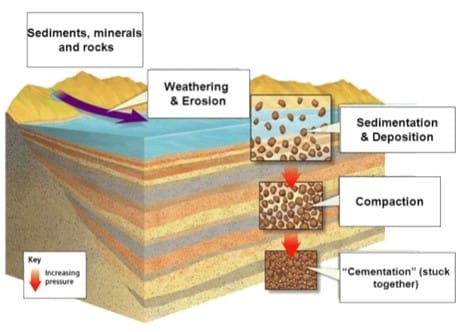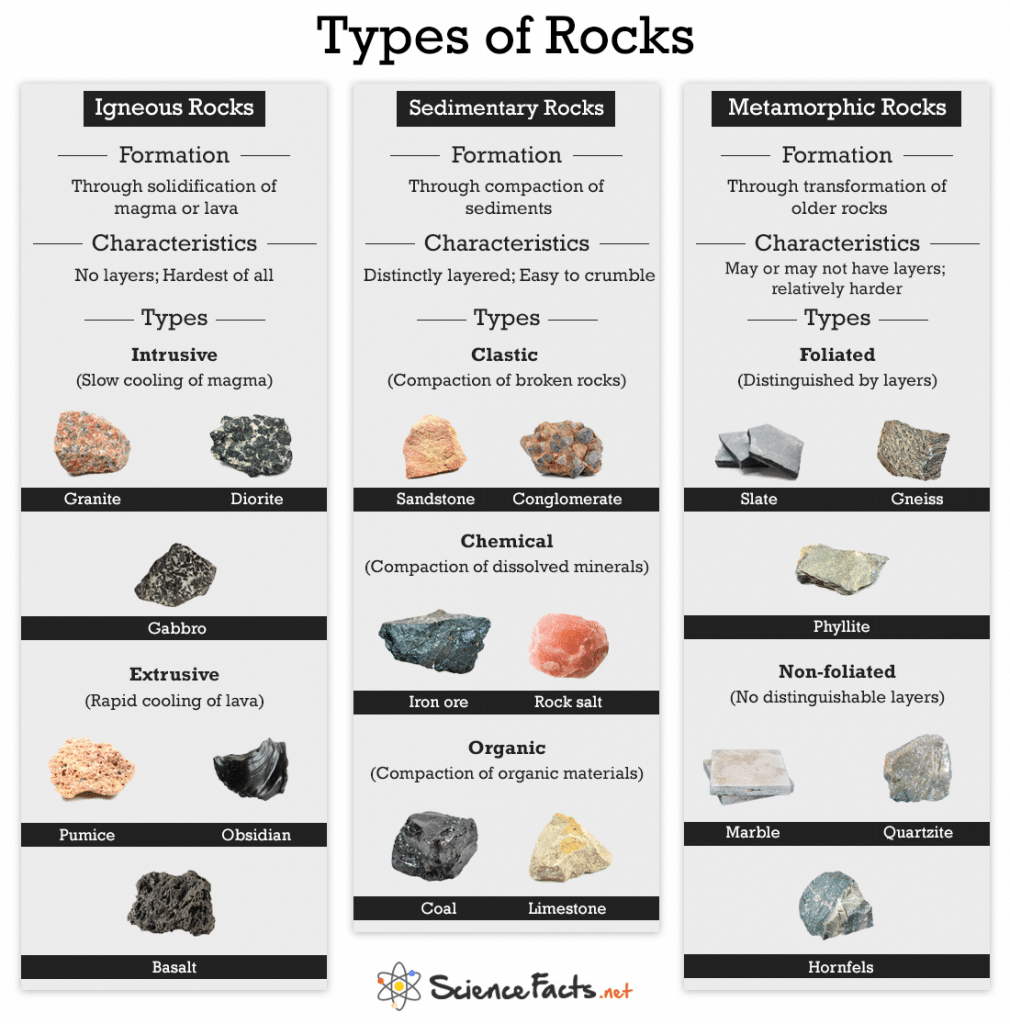Section 4: Rock Groups
Igneous rocks are the most common rocks found on Earth. They form on or beneath the Earth’s surface as magma rises and cools on the surface. When magma cools and hardens, it is called crystallization. If magma cools slowly and hardens underground, the rock formed is called an intrusive rock because the magma pushes into the crust. When magma erupts at the surface of the Earth, it’s called lava. Extrusive rocks are igneous rocks from lava that have erupted onto Earth’s surface. If a rock is small with crystals that are hard to see, it is extrusive. If a rock is large and interlocking, then it is intrusive.
Geologists determine whether an igneous rock is extrusive or intrusive based on its texture. First, they look at the shape of the crystals that make up the mineral’s grains. Rocks can be coarse, medium, or fine-grained, and sometimes a combination. Igneous rock often contains grains that are either coarse or fine, depending on whether they develop deep in the crust or at the surface. Granite is an intrusive igneous rock with large crystals, usually pale pink or gray. Obsidian is an extrusive igneous rock that is black and glassy. You cannot see its crystals because it forms from lava that cooled very quickly on the Earth’s surface.
 Sediment is a small, solid material that comes from rocks or remains of living things such as shells, leaves, bones, and stems. Sedimentary rocks are mainly formed through a series of processes. Erosion is when wind and water scrape away at rock until tiny bits fall off. The sediment particles are then carried away from their source. Sometimes rain or heavy winds start to erode rock and change its shape. Deposition is the process by which sediment settles out of the water or wind carrying it. Sediment is continuously being compacted as new layers pile on top of it. Compaction is the process that presses sediment together, growing thick layers that build up over millions of years. Cementation is when dissolved minerals crystallize and glue sediment particles together. Sometimes dead plants or animals fall onto a sedimentary rock, which is how fossils form.
Sediment is a small, solid material that comes from rocks or remains of living things such as shells, leaves, bones, and stems. Sedimentary rocks are mainly formed through a series of processes. Erosion is when wind and water scrape away at rock until tiny bits fall off. The sediment particles are then carried away from their source. Sometimes rain or heavy winds start to erode rock and change its shape. Deposition is the process by which sediment settles out of the water or wind carrying it. Sediment is continuously being compacted as new layers pile on top of it. Compaction is the process that presses sediment together, growing thick layers that build up over millions of years. Cementation is when dissolved minerals crystallize and glue sediment particles together. Sometimes dead plants or animals fall onto a sedimentary rock, which is how fossils form.
Sedimentary rock can be classified into two groups according to its composition and how it forms. Rocks that are broken into pieces of minerals and rock fragments are known as clastic rocks, such as sandstone. When minerals crystallize directly from water, like limestone, chemical rocks form called non-clastic rocks. Chemical rocks are generally composed of one dominant mineral and are uniform in color. Biochemical rocks are sedimentary rocks that are created by organisms or contain the remains of organisms, like coal. Sedimentary rocks are made of fragments of other rocks cemented together. They have a wide range of grain sizes, from a tiny piece of clay to a huge boulder.
Heat and pressure deep beneath Earth’s surface can change any rock into metamorphic rock. Metamorphic rock forms when heat or pressure changes igneous, sedimentary, or metamorphic rocks that already exist. When magma rises beneath Earth’s surface, it heats the rock around it. This extreme heat causes a rock to melt, and when the rock cools, new minerals form. Pressure also increases as you go deeper into the crust. As a result, the buried rocks experience an increase in pressure, which causes the minerals in the rock to change into different minerals. This creates a new metamorphic rock.
Metamorphic rocks often look similar to sedimentary rocks, but they are classified into two groups depending on whether they have bands. Foliated rocks have bands of different mineral grains arranged in layers. If a rock is non-foliated, the mineral grains are arranged randomly. Many rocks show signs of distortion or blending due to extreme heat and pressure during the rock cycle. Gneiss is a foliated metamorphic rock that forms from mudstone, an igneous rock.

Review:
- What are the most common type of rocks found on Earth?
- Explain deposition and compaction.
- What is the difference between clastic and non-clastic rocks?
